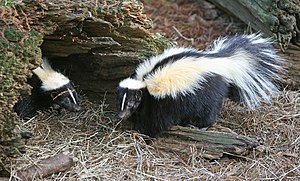Field Guide/Mammals/Striped Skunk
< Field Guide | Mammals
| Mephitis mephitis (Striped Skunk) | |
|---|---|
|
Family: Mephitied
Size: The skunk ranges anywhere from 20 to 30 inches (575 mm to 800 mm) and weigh anywhere from 42 to 186 oz (1200 to 5300 g) with a long fluffy tail.[1]
Description: The striped skunk is known for having large stripes along its back. Starting as one from the top of the head, these stripes then break into two or more strips along the back. Each skunk has an individual stripe pattern from one another. Their tails are very large and bushy with both black and white fur in it.[1]
Similar Species: With small ears and triangle shaped head, the skunk takes on a similar shape of that as a cat differing with short legs and webbed toes with long nails for digging.[1]
Range: The striped skunk is only found on the continent of North America. Not only in the United States, the striped skunk runs all the way from Central Canada to Northern Mexico.[1]
Habitat: Although the striped skunk never lives far from water, the striped skunk lives in a lot of different habitats. They tend to live in open areas in the woods, grasslands and meadows. They like to make dens in places that are warm such as caves, stumps, logs and rock openings.[1][2]
Diet: The striped skunk eats both meat and plants. It eats things such as insects, small mammals, fish, fruits, nuts and leaves. This species also likes to eat fruits and vegetables when they are ripe in the summer months. Most of the time skunks dig to find their food buried in the ground and often come across the eggs of other animals to eat.[1]
Activity: The skunk is mostly nocturnal. It will sleep during the day and hunt for its food during the hours of night. Striped skunks normally live in a burrow that they find that is abandon and make it their own. They are inactive from November to March for the most part but do not hibernate.[1][2]
Reproduction: Mating season starts at mid-February and go through mid-March. Two months after mating, around five or six baby skunks are born per litter. Born both blind and deaf, a baby will nurse in the den with the mother for almost two months and will then stay with the mother for almost a year after birth before weaning onto their own. Male skunks provide no parental care and females only have one litter per year.[1]
Lifespan: Up to 90% of striped skunks die in their first winter but some can live up to two or three years old in the wild.[1]
Notes: Striped skunks might like to live in open wooded areas but they also like to wonder into suburban areas because they like the buildings that are there to give them cover if they ever need it. Males provide no parental care after birth because females will no longer associate with the male except for the few days during fertilization. The dens in winter usually consist of separate male and females. Most mothers will hibernate in packs of six with their young. The striped skunk is mostly known for its defensive system. When it feels in danger, it will lift its tail, arch its back and spray two streams of fluid from their scent glands. The spray causes nausea and burns the eyes of the predator.[1]
|
 |